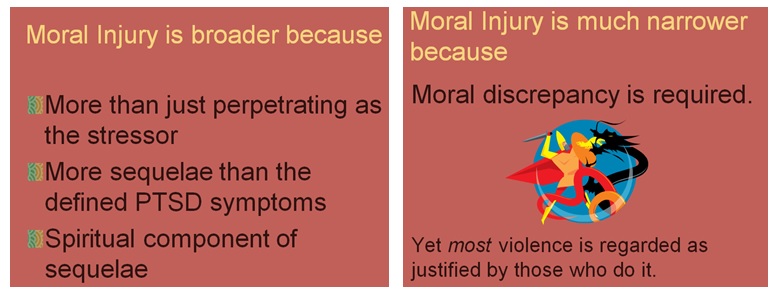What Is Moral Injury?
“Moral Injury” is a recent concept, introduced in an article by Litz et al. in 2009. Authors say, “We are not arguing for a new diagnostic category, per se, nor do we want to medicalize or pathologize the moral and ethical distress.”
Definitions:

Note that while perpetrating is the first thing on the list, the list includes other items, so this definition expands beyond what Perpetration-Induced Traumatic Stress (PITS) covers.
On the other hand, it also requires an awareness of transgression, which makes it much narrower than PITS. For PITS, the act is sufficient. The attitude about the act and the interpretation of it are variables rather than a necessary component.

This is a major difference; as Fiske & Rai (2015) detail in a book called Virtuous Violence, all throughout history, from acts of the gods to corporal punishment of children, from illegal criminal enterprises to court-ordered executions, people have felt their acts of violence to not merely be justified or acceptable, but positively virtuous and necessary – motivated by moral sentiments.

Components of Moral Injury
Compared to PITS
Guilt, Shame, and Self-Deprecation
The American Psychiatric Association’s DSM-IV diagnostic manual was published in 1994. Its definition of PTSD didn’t have guilt or shame as one of the symptoms. Therefore, the original article introducing the idea of moral injury suggested that such constructs as shame were one of the things that differentiated moral injury from PTSD (Litz, 2009, p. 699).
However, the DSM-5 was published in 2013, and Symptom Cluster D, number 4 does directly include guilt and shame along with horror and other negative emotions.
Cognitive Dissonance
“Cognitive dissonance” is a long-established idea in psychology, first introduced by Leon Festinger in 1957. Any bit of knowledge a person has about self or environment is a “cognition” – facts, concepts, moral principles, etc. If two cognitions contradict, then the two elements are “dissonant.” Whenever someone has any cognitions that disagree with each other, she or he experiences cognitive dissonance. This has long been recognized as a tension, a stress that people try to relieve. Therefore, while PTSD is one kind of stress, cognitive dissonance is another.
When one cognition is the fact of behavior that happened – and since it happened in the past it can’t be changed – and the other cognition is a moral belief that contradicts it, then cognitive dissonance must occur.
The definition of moral injury therefore makes cognitive dissonance a necessary component. It will often accompany PITS as well. However, if a person does misremember or re-interpret the event, change their moral principles, or start out with moral principles that allowed the action, the concept of PITS still applies. PTSD symptoms are separate from cognitive dissonance.
Spiritual or Existential Problems
The study on combat veteran’s narratives reported that in addition to loss of trust, “Spiritual/Existential Problems” were higher than other moral-injury (MI) themes. (Vargas, et al., 2013, p. 248). They report:
Civilian Deaths or Other Disproportionate Violence were the most likely MI events to have associated signs and symptoms reported [compared with Betrayal Events and Within-Ranks Violence] . . . These findings suggest that civilian deaths (or disproportionate violence) may have a unique impact on an individual’s Spiritual Existential functioning, and that this type of MI should be emphasized when considering appropriate interventions” (Vargas, et al., p. 248)
Another study looked especially at the making of meaning out of events, and drew this conclusion (“MIEs” means “Morally Injurious Events):
For Veterans who organized their meaning systems along religious and/or spiritual lines, MIEs might cause them to question their faith and/or engender intense turmoil in their relationship with God or higher power. In turn, they could also experience discomfort in their religious/spiritual communities and withdraw from practices and/or relationships that had served as important resources for coping. In these ways, spiritual struggles might exacerbate and even perpetuate mental health problems for many morally injured Veterans. (Currier, Holland & Malott, 2015, p. 237)
Such struggles would clearly be associated with PITS and would be a necessary part of studying the phenomenon and how to provide treatment for it. For Moral Injury, however, this is a definitional component, rather than an associated point.
Time Delay
Finally, we have a component that’s the same for both: the DSM-5 definition of PTSD explicitly allows for symptoms to arise long after the event, even if the event is causing those symptoms. In the same way, the Moral Injury literature has noted that symptoms need not be immediate.
For example, police brutality under the apartheid regime in South Africa could have been regarded as entirely justified at the time but more mentally devastating when its participants appeared in front of the Truth and Reconciliation Commission.
References
Currier, J. M., Holland, J. M. & Malott, J. (2015). Moral Injury, meaning making, and mental health in returning veterans. Journal of Clinical Psychology, 71(3), 229-240. doi: 10.1002/jclp.22134
Fiske, A. P. & Rai, T. S. (2015). Virtuous Violence. Cambridge: Cambridge University Press.
Litz, Brett. T., Stein, N., Delaney, E., Lebowitz, L., Nash, W. P., Silva, C., & Maguen, S. (2009). Moral injury and moral repair in war veterans: A preliminary model and intervention strategy. Clinical Psychology Review, 29, 695–706. doi: 10.1016/j.cpr.2009.07.003
Vargas, A. F., Hanson, T., Kraus, D., Drescher, K., & Foy, D. (2013). Moral injury themes in combat veterans’ narrative responses from the National Vietnam Veterans’ Readjustment Study. Traumatology, 19, 243-250. doi:10.1177/1534765613476099
Other Pages:
Home Page: basic explanation.
Personal Stories from biographies and autobiographies throughout history, from a variety of kinds of violence.
Classic Literature shows the cross-cultural observations of keen observers of the human condition.
Study of Veterans – What an analysis of the U.S. government’s data on 1,638 combat veterans of the American war in Vietnam shows